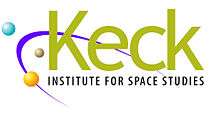Keck Institute for Space Studies
The Keck Institute for Space Studies (KISS) is a joint institute of the California Institute of Technology and the Jet Propulsion Laboratory established in January 2008 with a $24 million grant from the W. M. Keck Foundation. It is a privately funded think tank focused on space mission concepts and technology.
The 2011-2014 Global Go To Think Tank Index Reports (Think Tanks and Civil Societies Program, University of Pennsylvania), have listed KISS in the "Top Thirty Science and Technology Think Tanks".[1]
The Founding Director of the Institute is Professor Tom Prince (2008–present).
History
Keck Institute for Space Studies was established in 2008 for the purpose of developing new ideas for revolutionary advances in space missions. It is funded by the W M Keck Foundation with a grant of $3 million per year over eight years and aims to bring together scientists and engineers from a broad range of backgrounds for sustained technical interactions.[2]
Programs

Forty-one programs have completed their initial studies since 2008. In 2015, five new studies are in progress:
- Optical Frequency Microcombs for Space Applications
- Methane on Mars
- Don't Follow (Just) the Water: Does Life Occur in Non-Aqueous Media?
- Exploring New Multi-Instrument Approaches to Observing Terrestrial Ecosystems and the Carbon Cycle From Space
- Three Dimensional (3D) Additive Construction for Space using In-Situ Resources
Previously completed programs include:
2014 Programs:
- Science and Enabling Technologies to Explore the Interstellar Medium
- Bridging the Gap: Observations and Theory of Star Formation Meet on Large and Small Scales
- Gazing at the Solar System: Capturing the Evolution of Dunes, Faults, Volcanoes and Ice from Space
- Mapping and Assaying the Near Earth Object Population Affordably on a Decadal Timescale
- Adaptive Multi-Functional Space Structures for Micro-Climate Control
- Venus Seismology
2013 Programs:
- The Sleeping Giant: Measuring Ocean Ice Interactions in Antarctica
- Airships: A New Horizon for Science
- New Approaches to Lunar Ice Detection and Mapping
- Planetary Magnetic Fields: Planetary Interiors and Habitability
- Satellites to the Seafloor: Autonomous Science to Forge a Breakthrough in Quantifying the Global Ocean Carbon Budget
2013 Student-Led Programs:
- Inferring Thermal and Mechanical Properties of Celestial Bodies Regolith Using (Simple) Low-Tech Tools
2012 Programs:
- New Methods to Measure Photosynthesis from Space
- In Situ Science and Instrumentation for Primitive Bodies
- Quantum Communication, Sensing and Measurement in Space
- Engineering Resilient Space Systems
- Small Satellites: A Revolution in Space Science
- CMB Polarization Cosmology in the Coming Decade
2012 Student-Led Program:
- Tools and Algorithms for Sampling in Extreme Terrain
2011 Programs:
- Asteroid Return Mission Study
- Digging Deeper: Algorithms for Computationally-Limited Searches in Astronomy
- Next Generation UV Instrument Technologies Enabling Missions in Astrophysics, Cosmology and Planetary Sciences
- Monitoring of Geoengineering Effects and their Natural and Anthropogenic Analogues
- xTerramechanics - Integrated Simulation of Planetary Surface Missions
2011 Student-Led Programs:
- High Altitude Ballooning for Space and Atmospheric Observation
- Caltech Space Challenge
2010 Programs:
- Future Missions to Titan: Scientific and Engineering Challenges
- The First Billion Years
- Innovative Satellite Observations to Characterize the Cloudy Boundary Layer
2009/2010 Programs:
- Monitoring Earth Surface Changes from Space
- Single Photon Counting Detectors
- Innovative Approaches to Exoplanet Spectra
- Quantifying the Sources and Sinks of Atmospheric CO2
- Innovative Approaches to Planetary Seismology
2008/2009 Programs:
- New Directions in Robotic Exploration of Mars
- Coherent Arrays for Astronomy and Remote Sensing
- Large Space Structures
- Climate Feedbacks and Future Remote Sensing Observations
- Shedding Light on the Nature of Dark Matter
- Mission Concepts for Accessing and Sampling High-Risk Terrains on Planetary Surfaces
- Innovative Concepts in IR/Submm Astronomy from Space
Location
The Keck Institute for Space Studies is located in the Keck Center, which includes two buildings: the renovated Tolman/Bacher House and a new structure erected next door. The center, designed by Lehrer Architects, was dedicated on September 15, 2014, to honor the long-term support of Caltech by the W. M. Keck Foundation and its founder William Myron Keck.
The Tolman/Bacher house has been a home to two Caltech professors - Richard Tolman and Robert Bacher. Richard and Ruth Tolman lived here from the time the house was built in 1925-1926 until their deaths in 1948 and 1957, respectively. The house then passed to the Bachers, Robert and Jean, who were close friends of the Tolmans and lived here until 1988.[3]
The Keck Center was recently given LEED (Leadership in Energy and Environmental Design) Platinum certification, the highest level of recognition for sustainability given by the U.S. Green Building Council. The project earned points for stabilizing and restoring the Tolman/Bacher House and for incorporating such details into the new building as abundant natural light, natural ventilation, and the ability to open up the lobby of the new building to take advantage of the complex's indoor and outdoor spaces.[4]
References
- ↑ James G. McGann (Director) (January 20, 2012). "The Global Go To Think Tank Report, 2011" (PDF). Retrieved June 10, 2014.
- ↑ http://www.research-europe.com/index.php/2012/12/tom-prince-director-caltechs-keck-institute-for-space-studies/
- ↑ http://kiss.caltech.edu/Tolman-Bacher/index.html
- ↑ https://www.caltech.edu/news/kiss-think-and-do-tank-space-work-43702
External links
- KISS website
- Asteroid Return Paper
- KISS on iTunes-U
- KISS YouTube Videos
- Tom Prince, Director, Caltech’s Keck Institute for Space Studies
- KISS: A Think and Do Tank for Space Work
- Tolman/Bacher Website
Coordinates: 34°08′12″N 118°07′34″W / 34.1368°N 118.1260°W